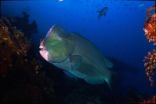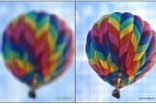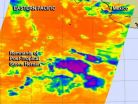(Press-News.org) As the climate warms and sea ice retreats, the North is changing. An ice-covered expanse now has a season of increasingly open water which is predicted to extend across the whole Arctic Ocean before the middle of this century. Storms thus have the potential to create Arctic swell – huge waves that could add a new and unpredictable element to the region.
A University of Washington researcher made the first study of waves in the middle of the Arctic Ocean, and detected house-sized waves during a September 2012 storm. The results were recently published in Geophysical Research Letters.
"As the Arctic is melting, it's a pretty simple prediction that the additional open water should make waves," said lead author Jim Thomson, an oceanographer with the UW Applied Physics Laboratory.
His data show that winds in mid-September 2012 created waves of 5 meters (16 feet) high during the peak of the storm. The research also traces the sources of those big waves: high winds, which have always howled through the Arctic, combined with the new reality of open water in summer.
Arctic ice used to retreat less than 100 miles from the shore. In 2012, it retreated more than 1,000 miles. Wind blowing across an expanse of water for a long time creates whitecaps, then small waves, which then slowly consolidate into big swells that carry huge amounts of energy in a single punch.
The size of the waves increases with the fetch, or travel distance over open water. So more open water means bigger waves. As waves grow bigger they also catch more wind, driving them faster and with more energy.
Shipping and oil companies have been eyeing the opportunity of an ice-free season in the Arctic Ocean. The emergence of big waves in the Arctic could be bad news for operating in newly ice-free Northern waters.
"Almost all of the casualties and losses at sea are because of stormy conditions, and breaking waves are often the culprit," Thomson said.
It also could be a new feedback loop leading to more open water as bigger waves break up the remaining summer ice floes.
"The melting has been going on for decades. What we're talking about with the waves is potentially a new process, a mechanical process, in which the waves can push and pull and crash to break up the ice," Thomson said.
Waves breaking on the shore could also affect the coastlines, where melting permafrost is already making shores more vulnerable to erosion.
The observations were made as part of a bigger project by a sensor anchored to the seafloor and sitting 50 meters (more than 150 feet) below the surface in the middle of the Beaufort Sea, about 350 miles off Alaska's north slope and at the middle of the ice-free summer water. It measured wave height from mid-August until late October 2012.
Satellites can give a rough estimate of wave heights, but they don't give precise numbers for storm events. They also don't do well for the sloppy, partially ice-covered waters that are common in the Arctic in summer.
Warming temperatures and bigger waves could act together on summer ice floes, Thomson said: "At this point, we don't really know relative importance of these processes in future scenarios."
Establishing that relationship could help to predict what will happen to the sea ice in the future and help forecast how long the ice-free channel will remain open each year.
The recent paper recorded waves at just one place. This summer Thomson is part of an international group led by the UW that is putting dozens of sensors in the Arctic Ocean to better understand the physics of the sea-ice retreat.
"There are several competing theories for what happens when the waves approach and get in to the ice," Thomson said. "A big part of what we're doing with this program is evaluating those models."
He will be out on Alaska's northern coast from late July until mid-August deploying sensors to track waves. He hopes to learn how wave heights are affected by the weather, ice conditions and amount of open water.
"It's going to be a quantum leap in terms of the number of observations, the level of detail and the level of precision" for measuring Arctic Ocean waves, Thomson said.
INFORMATION:
The other author is W. Erick Rogers at the Naval Research Laboratory. The research was funded by the U.S. Office of Naval Research.
For more information, contact Thomson at 206-616-0858 or jthomson@apl.washington.edu. He will be deploying sensors out of Prudhoe Bay from July 24 to Aug. 4 and have email access about once a day.
Huge waves measured for first time in Arctic Ocean
2014-07-29
ELSE PRESS RELEASES FROM THIS DATE:
Underwater elephants
2014-07-29
In the high-tech world of science, researchers sometimes need to get back to basics. UC Santa Barbara's Douglas McCauley did just that to study the impacts of the bumphead parrotfish (Bolbometopon muricatum) on coral reef ecosystems at two remote locations in the central Pacific Ocean.
Using direct observation, animal tracking and computer simulation, McCauley, an assistant professor in the Department of Ecology, Evolution and Marine Biology, and his colleagues sought to understand whether the world's largest parrotfish is necessary for positively shaping the structure ...
Vision-correcting display makes reading glasses so yesterday
2014-07-29
BERKELEY — What if computer screens had glasses instead of the people staring at the monitors? That concept is not too far afield from technology being developed by computer and vision scientists at the University of California, Berkeley.
The researchers are developing computer algorithms to compensate for an individual's visual impairment, and creating vision-correcting displays that enable users to see text and images clearly without wearing eyeglasses or contact lenses. The technology could potentially help hundreds of millions of people who currently need corrective ...
Researchers take steps toward development of a vaccine against tick-transmitted disease
2014-07-29
Virginia Commonwealth University School of Medicine researchers have made an important advancement toward developing a vaccine against the debilitating and potentially deadly tick-transmitted disease, human granulocytic anaplasmosis (HGA).
During the past several years, experts have seen a steady rise in the incidence of human infections caused by tick-transmitted bacterial pathogens — making the need for a vaccine critical. Successful vaccine development hinges on knowing what to target to prevent disease, and the VCU team has identified three such proteins on the surface ...
Brainwaves can predict audience reaction for television programming
2014-07-29
Media and marketing experts have long sought a reliable method of forecasting responses from the general population to future products and messages. According to a study conducted at the City College of New York (CCNY) in partnership with Georgia Tech, it appears that the brain responses of just a few individuals are a remarkably strong predictor.
By analyzing the brainwaves of 16 individuals as they watched mainstream television content, researchers were able to accurately predict the preferences of large TV audiences, up to 90 percent in the case of Super Bowl commercials. ...
Socialization relative strength in fragile X longitudinal study
2014-07-29
Standard scores measuring "adaptive behavior" in boys with fragile X syndrome tend to decline during childhood and adolescence, the largest longitudinal study of the inherited disorder to date has found.
Adaptive behavior covers a range of everyday social and practical skills, including communication, socialization, and completing tasks of daily living such as getting dressed. In this study, socialization emerged as a relative strength in boys with fragile X, in that it did not decline as much as the other two domains of adaptive behavior measured: communication and daily ...
Brand-specific television alcohol ads predict brand consumption among underage youth
2014-07-29
Underage drinkers are three times more likely to drink alcohol brands that advertise on television programs they watch compared to other alcohol brands, providing new and compelling evidence of a strong association between alcohol advertising and youth drinking behavior.
This is the conclusion of a new study from the Center on Alcohol Marketing and Youth (CAMY) at the Johns Hopkins Bloomberg School of Public Health and the Boston University School of Public Health that examined whether exposure to brand-specific alcohol advertising on 20 television shows popular with ...
$15 billion annual public funding system for doctor training needs overhaul, says IOM
2014-07-29
WASHINGTON -- The U.S. should significantly reform the federal system for financing physician training and residency programs to ensure that the public's $15 billion annual investment is producing the doctors that the nation needs, says a new report by the Institute of Medicine. Current financing -- provided largely through Medicare -- requires little accountability, allocates funds independent of workforce needs or educational outcomes, and offers insufficient opportunities to train physicians in the health care settings used by most Americans, the report says.
All ...
A new way to make microstructured surfaces
2014-07-29
A team of researchers has created a new way of manufacturing microstructured surfaces that have novel three-dimensional textures. These surfaces, made by self-assembly of carbon nanotubes, could exhibit a variety of useful properties — including controllable mechanical stiffness and strength, or the ability to repel water in a certain direction.
"We have demonstrated that mechanical forces can be used to direct nanostructures to form complex three-dimensional microstructures, and that we can independently control … the mechanical properties of the microstructures," says ...
NASA sees warmer cloud tops as Tropical Storm Hernan degenerates
2014-07-29
Tropical Storm Hernan degenerated into a remnant low pressure area on July 29. Infrared imagery from NASA's Aqua satellite revealed cloud tops were warming as the storm weakened.
The Atmospheric Infrared Sounder or AIRS instrument aboard Aqua gathered infrared data on a quickly weakening Hernan on July 29 at 5:11 a.m. EDT. The data was then made into a false-colored image at NASA's Jet Propulsion Laboratory in Pasadena, California. The AIRS image showed small, fragmented areas of a few powerful thunderstorms with high, cold cloud tops in Tropical Storm Hernan as it continued ...
Superconductivity could form at high temperatures in layered 2-D crystals
2014-07-29
An elusive state of matter called superconductivity could be realized in stacks of sheetlike crystals just a few atoms thick, a trio of physicists has determined.
Superconductivity, the flow of electrical current without resistance, is usually found in materials chilled to the most frigid temperatures, which is impractical for most applications. It's been observed at higher temperatures–higher being about 100 kelvin or minus 280 degrees below zero Fahrenheit–in copper oxide materials called cuprate superconductors. But those materials are brittle and unsuitable for fabricating ...


